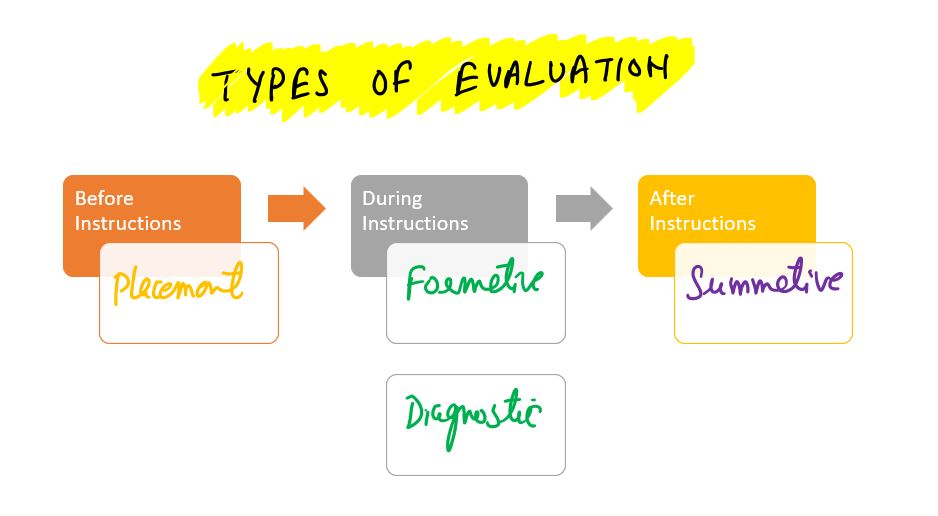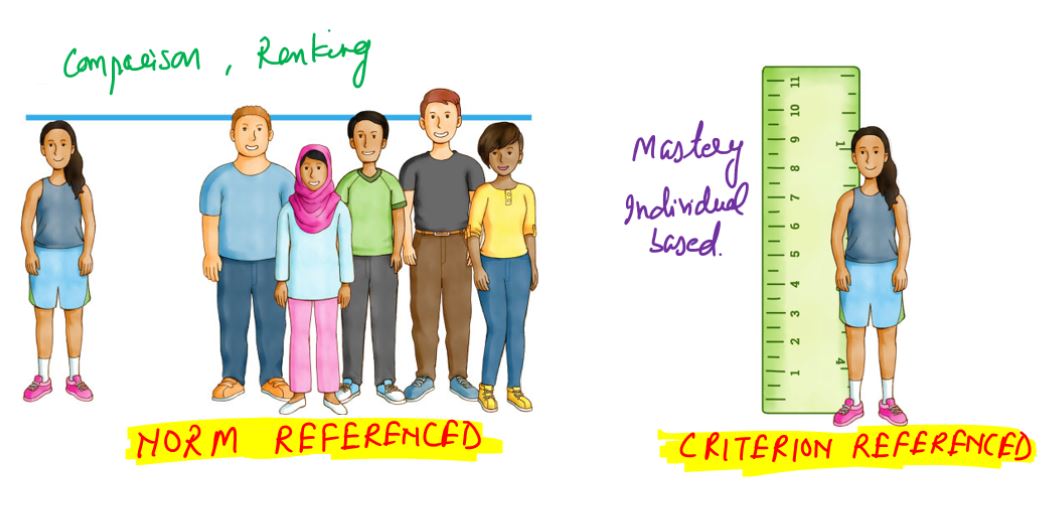Types of Evaluation
Evaluation in the educational landscape serves as a multifaceted tool with the power to guide decision-making, improve teaching and learning, and determine the effectiveness of educational programs. When exploring the world of evaluation, two crucial categorizations emerge – one based on its function, and the other based on its interpretation.
These are discussed below.
1. Types of Evaluation on the basis of Function
There are 4 types /approaches of Evaluation on the basis of function.

1. Placement Evaluation
It is conducted before teaching-learning activities and assesses learners’ existing knowledge and experiences. It helps the teacher design instruction based on the learners’ entry behavior and determine their ability to acquire new knowledge. For example, pre-testing students on basic math skills before starting a new unit to understand their existing knowledge.
2. Formative Evaluation
It is introduced by Michael Scriven, monitors the learning progress of learners during the development or improvement of a program or product. It is conducted throughout the teaching-learning process and aims to improve instruction and learner outcomes. For example, using weekly quizzes to track students’ understanding of a science concept and adjusting lesson plans accordingly.
3. Diagnostic Evaluation
It is conducted alongside formative evaluation to identify and address learning difficulties observed during the instructional process. It helps pinpoint specific areas of difficulty and provides remedial treatment to overcome them. For example, noticing a group of students struggling with fractions and conducting additional assessments to pinpoint the exact areas of difficulty.
4. Summative Evaluation
It is conducted at the end of a teaching period to determine the extent to which instructional objectives have been achieved. It involves assigning grades or certifying student mastery and provides information for assessing the appropriateness of course objectives and instructional effectiveness. For example, administering a final exam at the end of the semester to assess overall student performance and determine grades.
2. Types of Evaluation on the basis of reference or Interpretation
There are 2 types /approaches of Evaluation on the basis of reference or interpretation.

1. Norm-referenced Evaluation
It involves comparing a student’s performance to that of their same-age peers on the same assessment. It provides a relative measure of performance by determining where a student stands in relation to others in the group. For example, in a norm-referenced standardized test, a student’s score will indicate how they performed compared to other students of the same age. The emphasis is on rank or percentile scores, allowing for comparisons among students.
2. Criterion-referenced Evaluation
It assesses a student’s performance based on the mastery of specific skills or objectives. It focuses on what the student knows and doesn’t know at the time of assessment, independent of how other students perform. For instance, a criterion-referenced assessment in mathematics may evaluate whether a student has achieved specific learning objectives, such as being able to solve equations or demonstrate understanding of geometric concepts. The emphasis is on determining individual proficiency and identifying areas for improvement.
Thus, Norm- and criterion-referencing provide two different frames of reference with which to interpret test scores. Norm- referenced scores give information about how a student did compared to other students taking the test, but isn’t specific about the student’s strengths or weaknesses in terms of content. Criterion-referenced assessments give more explicit information about the levels of achievement on the content, but don’t communicate how that student did compared to others.
UGC NET Previous Year Questions (Types of Evaluation)
1.) Given below are two statements: (09 July 2022 Morning)
Statement I: Assessment drives learning.
Statement II: No feedback is required to be given in formative assessments.
In the light of the above statements, choose the most appropriate answer from the options given below:
(A) Both Statement I and Statement II are correct.
(B) Both Statement I and Statement II are incorrect.
(C) Statement I is correct but Statement II is incorrect.
(D) Statement I is incorrect but Statement II is correct.
ANS. C
2.) Which of the following types of evaluation is done during the teaching-learning process? (21 Oct 2022 Evening)
(A) Summative
(B) Integrative
(C) Formative
(D) Diagnostic
ANS. C
3.) Match List I with List II gives their characteristic features: (20 Nov Evening 2021)
List I (Modes of Evaluation)
a. Formative Evaluation
b. Summative Evaluation
c. Criterion‐referenced Evaluation
d. Norm‐referenced Evaluation
List II (Characteristic Features)
i. Compares one student with another student.
ii. Compares the progress of a student against prespecified standards.
iii. Used primarily for motivational and monitoring purposes of learning.
iv. Used primarily for gradation of progress made.
Choose the correct answer from the options given below:
Codes
(A) a‐ iv, b‐ iii, c‐ i, d‐ ii
(B) a‐ iii, b‐ iv, c‐ ii, d‐ i
(C) a‐ ii, b‐ i, c‐ iii, d‐ iv
(D) a‐ i, b‐ ii, c‐ iv, d‐ iii
ANS. B
4.) Given below are two statements: (03 Dec Morning 2021)
Statement I: In norm-referenced testing of students, test data helps us determine a students place or rank.
Statement II: In Criterion-referenced testing, the test data tells us about a student’s level of proficiency.
In light of the above statements, choose the correct answer from the options given below:
(A) Both Statement I and Statement II are true.
(B) Both Statement I and Statement II are false.
(C) Statement I is true but Statement II is false.
(D) Statement I is false but Statement II is true.
ANS. A
5.) Given below are two statements: (21 Nov Morning)
One is labelled as Assertion A and the other is labelled as Reason R.
Assertion ‘A’: Formative assessment is process linked and directed at raising motivation and engagement levels in learning.
Reason ‘R’: The purpose of formative assessment is to improve quality of learning outcomes.
In the light of the above statements, Choose the most appropriate answer from the options given below:
Codes
(A) Both A and R are correct and R is the correct explanation of A.
(B) Both A and R are correct but R is NOT the correct explanation of A.
(C) A is correct but R is not correct.
(D) A is not correct but R is correct.
ANS. A
6.) Which of the characteristics in classroom teaching behaviour as given below will be classified as a part of formative assessment? (UGC NET 9th Oct 2020 Morning paper)
(i) The teacher asks question to elicit classification from students.
(ii) The teacher specifies the level of mastery attained by students.
(iii) The teacher prompts and probes the students while making presentation.
(iv) The teacher pauses for a few seconds, looks at students and asks questions.
(v) The teacher indicates performance criteria and given judgmental values.
Choose the correct answer from the options given below:
Codes
(A) (i), (ii) and (iii) only
(B) (i), (iii) and (iv) only
(C) (ii), (iii) and (iv) only
(D) (iii) (iv) and (v) only
ANS. B
7.) While reporting the result of assessment a college teacher makes use of percentile ranks in place of scores obtained by his/her students. What kind of evaluation will it be called? (UGC NET 30th Sept 2020 Morning paper)
(A) Criterion-referenced
(B) Norm-referenced
(C) Formative
(D) Summative
ANS. B
8.) Which of the following statements best describes “Summative Evaluation’ in evaluation procedures? (UGC NET 01st Mar 2023 Evening)
(A) The teacher clarifies the doubts of the students in the class itself.
(B) A teacher awards grades to the students after having transacted the course work.
(C) During interaction with students in the classroom, the teacher provides feedback.
(D) The learner’s motivation is raised by the teacher through a question- answer session during feedback.
ANS. B



